Abstract
Fecal incontinence, also referred to as accidental bowel leakage, is a debilitating condition that impacts quality of life in a significant number of women. Current treatments for fecal incontinence include behavioral modification, biofeedback, drug therapy, and invasive surgical procedures. However, these treatments have suboptimal efficacy due to patient adherence, variability of presentation across patients, cost, and additional health risks. A vaginal bowel control system (Eclipse™ System) was developed to offer a low-risk, effective, and patient-managed approach to treating accidental bowel leakage. The vaginal bowel control system consists of a vaginal insert and user-controlled, pressure-regulated pump. Once inflated, the balloon of the vaginal insert is directed posteriorly to occlude the rectum, allowing the woman to immediately regain control of bowel function. This article will introduce the design evolution and feasibility studies of the Eclipse System. In addition, this review will discuss the results from a recent clinical trial that demonstrated the safety and efficacy of the vaginal bowel control system in managing fecal incontinence and other symptoms of bowel dysfunction.
Overview of accidental bowel leakage
Accidental bowel leakage (ABL), a patient-centered term for fecal incontinence (FI),Citation1 is a socially debilitating condition that is characterized by involuntary loss of liquid or solid stool. In addition, ABL severity is influenced by frequency of leakage, stool consistency, and urgency. ABL prevalence rates range from 7% to 15% of community-dwelling women in the Western world with an estimated 20 million US women living with the condition.Citation2 In addition to increased rates with aging, women who have experienced pregnancy, childbirth, irritable bowel syndrome, or nerve damage to the pelvic region have greater risk for developing bowel dysfunction.Citation3–Citation5 Given that these rates may be underreported given some women’s resistance to seeking consultation, ABL represents a large unmet medical need in women’s health.
The pathophysiology of ABL is multifactorial and may vary by patient. Normal bowel control relies on anatomical integrity of internal anal sphincter, external anal sphincter, and puborectalis muscles; intact rectoanal sensation; and sufficient muscle response (contraction/relaxation), including the ability of the rectum to store fecal load until voluntary release (rectal compliance).Citation2 Dysfunction in any of these components independently or in combination can contribute to development of ABL, with factors ranging from iatrogenic, neurogenic (eg, peripheral neuropathy, central nervous system disease), or comorbidities (eg, anorectal inflammation associated with Crohn’s disease, ulcerative colitis). In women, ABL is often due to damaged or weakened anal sphincters, which can result from childbirth, reduced pelvic floor function, disturbed rectal sensation, or decreased rectal capacity.Citation1,Citation6,Citation7 Furthermore, aging is associated with weakness of internal and/or external sphincters.Citation8
ABL significantly impacts daily life and is associated with decreased self-confidence, self-respect, modesty, and composure. Patient responses to quality-of-life (QOL) questionnaires indicate that ABL restricts social life due to anxiety associated with knowing toilet location, hygiene/odor issues, coping strategies, physical activities, and embarrassment.Citation6,Citation9,Citation10 A woman with ABL may withdraw from social situations due to social stigma and discomfort in sharing her condition with family and friends. Barriers to seeking care include lack of understanding, embarrassment, belief that ABL is a normal part of aging, lack of appropriateness of care providers, and doubt that treatments can help.Citation11 QOL scores are highly correlated to ABL severity, emphasizing the need for effective treatments to manage bowel function to continue daily activities.
Most women with ABL do not seek medical treatment, utilizing self-managing strategies such as absorbent pads and diet restriction. Upon clinical counsel, conservative treatment options for ABL include dietary changes, medications, and pelvic floor muscle training with or without biofeedback. However, less than 25% of patients describe adequate relief with conservative management intervention.Citation12,Citation13 In patients who have failed conservative therapy, invasive surgical options include sphincteroplasty, sacral nerve stimulation, injection of bulking agents, radiofrequency energy delivery, and placement of an artificial bowel sphincter. The correction of rectal prolapse, including rectopexy, is an additional possible surgical treatment modality for FI. Surgical interventions for FI can be costly and invasive, can require complex management or the need for additional follow-up, and are associated with a 30%–50% failure rate during long-term evaluation.Citation14–Citation19
Design and features of the Eclipse System, a vaginal bowel control system for ABL
Given limitations in existing therapies, an unmet medical need remains for new, effective, and minimally invasive treatments for ABL. A vaginal bowel control (VBC) system (Eclipse™ System; Pelvalon, Sunnyvale, CA, USA) was developed to provide a low-risk and patient-managed approach to treating ABL, which could provide immediate effectiveness. Specifically, the Eclipse System consists of a vaginal insert and user-controlled, pressure-regulated pump (). The vaginal insert consists of a silicone-coated stainless steel base and posterior-directed, dual-layer balloon that provides reversible occlusion of the rectum, enabling the user to regain control of her bowel function ().
Figure 1 The vaginal bowel control (VBC) insert.
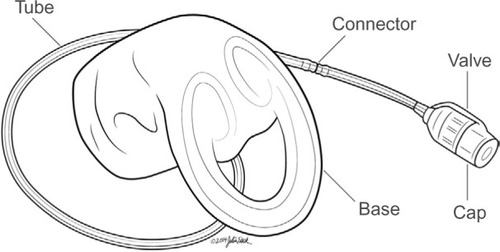
Figure 2 The vaginal bowel control insert deflated (A) and inflated (B).
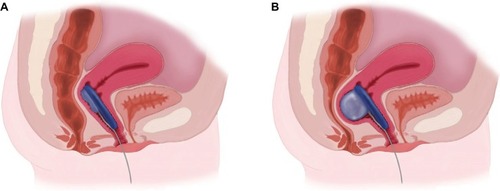
The insert, which is available in a range of base and balloon sizes, does not need to be removed for defecation, but can simply be deflated. The device can be fit and inserted in the clinic, then is easily controlled and removed or reinserted by the patient. For insertion, the user folds the insert along its length and places it into the vagina, balloon-end first and directed posteriorly (). It is recommended to remove the insert for cleaning once per week, as well as prior to sexual intercourse. For women who choose to use the insert during menstruation, daily cleaning is recommended. The tube, which extends outside of the vagina to allow for inflation and deflation, can be lengthened or shortened to patient preference, using a connector on the tube. The Eclipse System was initially approved by the US Food and Drug Administration in February 2015. This therapy fills a gap in the continuum of treatment for FI between conservative medical management and invasive surgery ().
Figure 3 Folding the vaginal bowel control insert for placement.
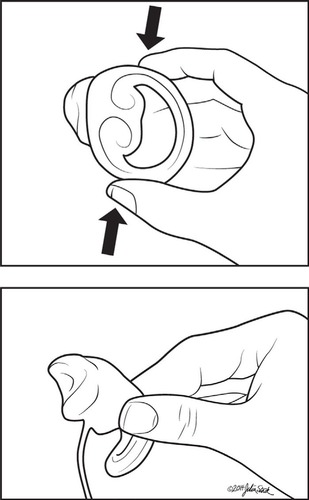
Medical device development typically involves multiple stages of evolution and evaluation driven by investigational trial use and standard care delivery. Following bench top and cadaveric testing for initial concept and design, optimization of clinical delivery and efficacy of the VBC system was achieved through staged human subject evaluations during short-term in-clinic use and short-term at-home wear, as described in the following section.
Clinical data and design evolution of the Eclipse System
Initial feasibility studies
We conducted the first-in-human study as a single-center prospective, open-label clinical study that included 13 women who sought treatment for ABL, defined as at least one stool leakage (solid or liquid) episode per month.Citation20,Citation21 Once consented, subjects were seen for a single clinic visit during which demographics, medical history, and questions regarding subjects’ FI symptoms were collected in a baseline questionnaire. A standard pelvic examination (vaginal speculum and digital rectal) was performed to assess the subject’s pelvic health prior to the initial fitting. During the fitting, the physician vaginally inserted the VBC device, assessing the fit and position of the insert and degree of rectal occlusion. Finally, the subject was asked to assess comfort in both the inflated and deflated state and after various types of subject movement (eg, sitting, standing, and ambulating). In addition, subjects were fitted with multiple sizes of inserts during their study visit to determine the most appropriate configuration, and comfort was assessed at various inflation pressures.
Physician examination confirmed that the inflated state of the VBC insert provided majority occlusion of the rectum. Overall, more than half of patients reported “no discomfort” during both deflated and inflated states of the vaginal insert. Furthermore, the majority of the patients indicated that they would wear the insert if allowed to continue participation beyond this single-visit study. No adverse events were reported. This first-in-woman study provided evidence that the novel concept of a VBC system for ABL was comfortable, well tolerated by subjects with ABL, and showed objective evidence of occluding the rectum.
A feasibility study consisting of staged, clinical evaluations was conducted to evaluate extended patient use of the VBC system in an outpatient setting and to confirm appropriateness of clinical protocol changes initiated following the first-in-woman study. Women with self-reported ABL extended the VBC system wear period to 1 week up to 1 month. A majority of women indicated desire for continued use after completion of the study, if allowed. Of the few adverse events, all were considered minor and resolved. (unpublished data, Takase-Sanchez M, 2014).
During the course of the first-in-human and feasibility studies, different versions of the device were evaluated, leading to enhanced comfort, stability, and effectiveness. Additionally, the cosmetic appearance of the system was modified to improve its appeal to patients. These different device versions integrated new designs in base shape and size, balloon shape and size, and the relative positioning of base and balloon. The softness and shape of the silicone covering was also designed to improve patient comfort, and the flexibility of the base was improved for ease of insertion and removal. Finally, a new pump (introduced commercially) was designed to provide improved ease of use, elegance, and discretion for women using the therapy ().
Figure 5 Updated vaginal bowel control system that enhances fit, stability, comfort, and appearance based on the feasibility studies (courtesy of Pelvalon).
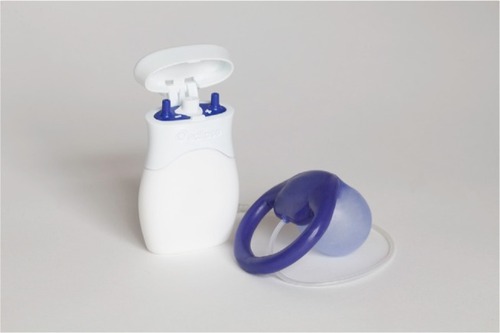
The feasibility studies also examined the various questionnaires, scores, and assessments available to evaluate ABL severity and symptoms. For future trials, it was determined that a 2-week bowel diary provided the appropriate level of information about device effectiveness for both accident reduction and change in important QOL-impacting symptoms such as fecal urgency, frequency, stool consistency, and completeness of evacuation. Additionally, validated and condition-specific QOL scores were identified as meaningful to the patient experience with the device: the Fecal Incontinence Quality of Life, Modified Manchester Health Questionnaire, as well as the Patient Global Impression of Improvement.
The LIFE clinical trial: safety and efficacy
A multicenter, prospective clinical trial was conducted to determine therapeutic efficacy and safety (primary end points) of the VBC system for women with ABL (LIFE Study, ClinicalTrials.gov, http://www.clinicaltrials.gov, NCT01655498).Citation22 Participant eligibility was determined using 2-week bowel diaries (baseline) that recorded the severity, consistency, and associated urgency of incontinent episodes. During the in-clinic fitting process, clinicians attempted to find a size and shape of the vaginal insert that was comfortable and could be appropriately positioned in the vagina, selecting from round or elliptical shapes in a range of sizes. In addition, the size of the inflatable balloon was determined based on vaginal caliber and rectal examination. If the insert was determined to be stable in both deflated and inflated position during the in-clinic visit, the subject went home for a 1-week trial. If the insert was comfortable, then the subject entered the clinical trial. However, if the insert was uncomfortable, the patient could return to the clinic for a refitting and another trial week. Patients exited the study after four failed trials.
Eligible participants with successful insert fittings completed at least 1 month of VBC system use and documented ABL symptoms during the final 2 weeks of the wear period (treatment bowel diary). Therapeutic efficacy was determined by comparing the frequency of FI episodes between the baseline and bowel diaries with treatment success defined as greater than 50% reduction in incontinent episodes. Adverse events were evaluated to assess safety. In addition, QOL measurements were collected as secondary outcomes. Women who completed the 1-month period were invited to extend use for a 2-month extended period (3 months total use).
Richter et al reported the primary outcomes from the trial, demonstrating successful efficacy and safety of the VBC system for treatment of ABL in women.Citation23 Of the 110 women who consented to participate and advanced to the fitting phase, 61 women entered the treatment period with 93% of subjects (n=56) completing the 1-month period per protocol (three withdrew from the trial, two did not fully complete treatment diaries). Eighty-six percent of the per protocol population had treatment success (≥50% reduction in episodes) with a significant decrease in ABL frequency from 11.66±9.65 per 2 weeks (baseline) to 2.16±2.9 episodes per 2 weeks with VBC system use for 1 month. Forty-one percent achieved complete continence. Forty-four women continued VBC system use for a total of 3 months. The majority of these participants (86%) met treatment success, with 20 women (46%) reporting complete continence ().
Figure 6 Within-subject efficacy of vaginal bowel control system wear on accidental bowel leakage (ABL) episodes.
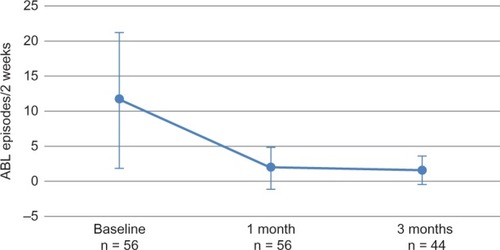
Mild and moderate adverse events experienced during the fitting period (47/110 participants, 42%) and 1-month treatment (14/61 participants, 23%) included pelvic cramping, urinary symptoms (including incontinence, urgency, frequency, and occasional difficulty in voiding), pelvic pain, vaginal spotting (fitting period only), and vaginal erythema, petechiae, or abrasions. It is noteworthy that adverse events associated with the VBC system decreased with time: 72% occurred during the fitting period with fewer reports at 1 month (20%) and 3 months (8%). No device-related adverse events were considered serious.
Furthermore, following 1-month use of the VBC system, participants reported significant improvement in Fecal Incontinence Quality of Life scores pertaining to lifestyle, coping behavior, and embarrassment, and in all categories of the Modified Manchester Health Questionnaire, except for the sleep and energy subscales where improvement was not significant. Most participants (90%) expressed high satisfaction with their experience using the device with 54 of 55 women reporting they would recommend the VBC system to a friend.
Although this intervention study was short term, the results demonstrate the value of utilizing the vaginal space for rapid and effective management of ABL early in the treatment process.
The LIFE clinical trial: impact of VBC system on bowel function parameters associated with ABL
Because several aspects of bowel function influence QOL, the authors conducted a secondary analysis on the LIFE clinical trial data to evaluate the VBC system’s effect on bowel movement frequency, urgency, stool consistency, and evacuation completeness.Citation24 According to bowel diary entries at baseline and following treatment, 1-month use of the VBC system was associated with a significant decrease in bowel movements in those women reporting high frequency of bowel movements (>2 per day) at baseline. In addition, fewer women reported liquid stools, urgency with bowel movements, and impaired evacuation. These data are particularly encouraging as these condition-specific symptoms of ABL are related to a woman’s QOL and her ability to fulfill desired daily activities.Citation25,Citation26
The LIFE clinical trial: successful fitting characteristics of the VBC system
The primary and secondary analyses of the LIFE clinical trial demonstrated the efficacy of the Eclipse System in treating incontinent episodes and bowel functions associated with ABL. However, the participants in the study represented only 55% (61/110) of the eligible enrollees, with the remaining potential subjects (n=49) excluded primarily due to unsuccessful fitting of the device. Additional analysis of this excluded population was performed to aid in future patient selection and clinical protocol.Citation27 Sixteen women were unsuccessful at the initial fitting and the remaining women (n=33) complained of discomfort or displacement during the trial period or withdrew (n=4). There were no differences in demographics, ethnicity, parity, menopausal status, body mass index, status of sexual activity, pelvic conditions, or comorbidity with irritable bowel syndrome between successful and failed fitting groups. Multivariate analysis indicated that women with previous pelvic prolapse surgery and women with shorter vaginal length were associated with an increased risk of an unsuccessful VBC insert fitting. These findings can be used to counsel patient expectations regarding the fitting experience. Furthermore, this information may guide consideration of new device size offerings to fit a higher percentage of patients in the future.
Next steps for the Eclipse System – the LIBERATE clinical study
The LIFE clinical trial provided initial demonstration of safety and efficacy of the Eclipse System following short-term use in women with ABL (). Future directions include continued clinical investigations of a larger cohort of responders to the Eclipse therapy, with a longer duration of wear to evaluate the durability of its long-term safety and effectiveness. A multicenter, prospective, open-label, 1-year outcome clinical study is currently underway (ClinicalTrials.gov https://clinicaltrials.gov/ct2/show/NCT02428595, ID NCT02428595, LIBERATE Trial)Citation28 to extend the support for the VBC system as a low-risk, patient-regulated treatment for ABL, restoring a woman’s ability to control her bowel function and return to her daily activities.
Table 1 Overview of a clinical evaluation of a VBC system for the treatment of fecal incontinence in women (LIFE Study, NCT01655498)
Conclusion
ABL is a devastating condition for women with few effective options. A novel concept, the VBC system, offers a noninvasive option for women suffering from loss of bowel control. Multiple feasibility studies and a pivotal study have demonstrated the potential for a VBC system to offer immediate effectiveness with minimal risk and a positive impact on QOL. Further, the VBC has demonstrated a positive impact on symptoms associated with ABL, including the urge to rush to a restroom for a bowel movement, loose stool, and frequent bowel movements.
Acknowledgments
This research was funded by the Wallace H. Coulter Translational Research Grant.
Disclosure
Since completion of this research, Dr Sokol has developed a consulting relationship with Pelvalon, Inc. The author reports no other conflicts of interest in this work.
References
- BrownHWWexnerSDSegallMMBrezoczkyKLLukaczESAccidental bowel leakage in the mature women’s health study: prevalence and predictorsInt J Clin Pract201266111101110823067034
- BharuchaAEDunivanGGoodePSEpidemiology, pathophysiol-ogy, and classification of fecal incontinence: state of the science summary for the National Institute of Diabetes and Digestive and Kidney Diseases (NIDDK) workshopAm J Gastroenterol201511012713625533002
- DitahIDevakiPLumaHNPrevalence, trends, and risk factors for fecal incontinence in United States adults, 2005–2010Clin Gastroenterol Hepatol2014124636643e1223906873
- WuJMVaughanCPGoodePSPrevalence and trends of symptomatic pelvic floor disorders in U.S. womenObstet Gynecol201412314114824463674
- WhiteheadWEBorrudLGoodePSFecal incontinence in US adults: epidemiology and risk factorsGastroenterology2009137512517517.e1219410574
- MeyerIRichterHEImpact of fecal incontinence and its treatment on quality of life in womenWomens Health (Lond Engl)201511222523825776296
- WangAGuessMConnellKPowersKLazarouGMikhailMFecal incontinence: a review of prevalence and obstetric risk factorsInt Urogynecol J Pelvic Floor Dysfunct200617325326015973465
- YuSWRaoSSAnorectal physiology and pathophysiology in the elderlyClin Geriatr Med20143019510624267605
- BrownHWWexnerSDSegallMMBrezoczkyKLLukaczESQuality of life impact in women with accidental bowel leakageInt J Clin Pract201266111109111623067035
- NortonCThomasLHillJGroupGDManagement of faecal incontinence in adults: summary of NICE guidanceBMJ200733476081370137117600027
- BrownHWWexnerSDLukaczESFactors associated with care seeking among women with accidental bowel leakageFemale Pelvic Med Reconstr Surg2013192667123442502
- HeymenSScarlettYJonesKRingelYDrossmanDWhiteheadWERandomized controlled trial shows biofeedback to be superior to pelvic floor exercises for fecal incontinenceDis Colon Rectum2009521730173719966605
- NortonCBehavioral management of fecal incontinence in adultsGastroenterology2004126S64S7014978640
- BrownSRWadhawanHNelsonRLSurgery for faecal incontinence in adultsCochrane Database Syst Rev20137CD00175723821339
- GlasgowSCLowryACLong-term outcomes of anal sphincter repair for fecal incontinence: a systematic reviewDis Colon Rectum20125548249022426274
- WexnerSDCollerJADevroedeGSacral nerve stimulation for fecal incontinence: results of a 120-patient prospective multicenter studyAnn Surg2010251344144920160636
- MelenhorstJKochSMUludagOvan GemertWGBaetenCGSacral neuromodulation in patients with faecal incontinence: results of the first 100 permanent implantationsColorectal Dis2007972573017509049
- HetzerFHBielerAHahnloserDLohleinFClavienPADemartinesNOutcome and cost analysis of sacral nerve stimulation for faecal incontinenceBr J Surg200693111411141717022014
- Bravo GutierrezAMadoffRDLowryACParkerSCBuieWDBaxterNNLong-term results of anterior sphincteroplastyDis Colon Rectum2004475727731 discussion 731–72215037931
- WhiteheadWERaoSSLowryATreatment of fecal incontinence: state of the science summary for the National Institute of Diabetes and Digestive and Kidney Diseases workshopAm J Gastroenterol201511013814625331348
- SokolERFirst-in-human acute assessment of a novel vaginal bowel control system for the treatment of fecal incontinence in womenJ Minim Invasive Gynecol2015223S53
- PelvalonA clinical evaluation of a vaginal bowel control system for the treatment of fecal incontinence in Women (LIFE) Available from: https://clinicaltrials.gov/ct2/show/NCT01655498Accessed April 26, 2016
- RichterHEMatthewsCAMuirTA vaginal bowel-control system for the treatment of fecal incontinenceObstet Gynecol201512554054725730213
- VarmaMGMatthewsCAMuirTImpact of a novel vaginal bowel control system on bowel functionDis Colon Rectum201659212713126734971
- MarklandADGreerWJVogtAFactors impacting quality of life in women with fecal incontinenceDis Colon Rectum2010531148115420628278
- StenzeliusKWestergrenAHallbergIRBowel function among people 75+ reporting faecal incontinence in relation to help seeking, dependency and quality of lifeJ Clin Nurs200716345846817335521
- MatthewsCAVarmaMTakase-SanchezMClinical characteristics associated with successful use of a novel vaginal bowel control system for the treatment of fecal incontinenceFemale Pelvic Med Reconstr Surg2016 accepted and in press
- PelvalonA clinical evaluation of the Eclipse™ system, a Vaginal Bowel Control (VBC) therapy for fecal incontinence in women (LIBERATE) Available from: https://clinicaltrials.gov/ct2/show/NCT02428595Accessed April 26, 2016

